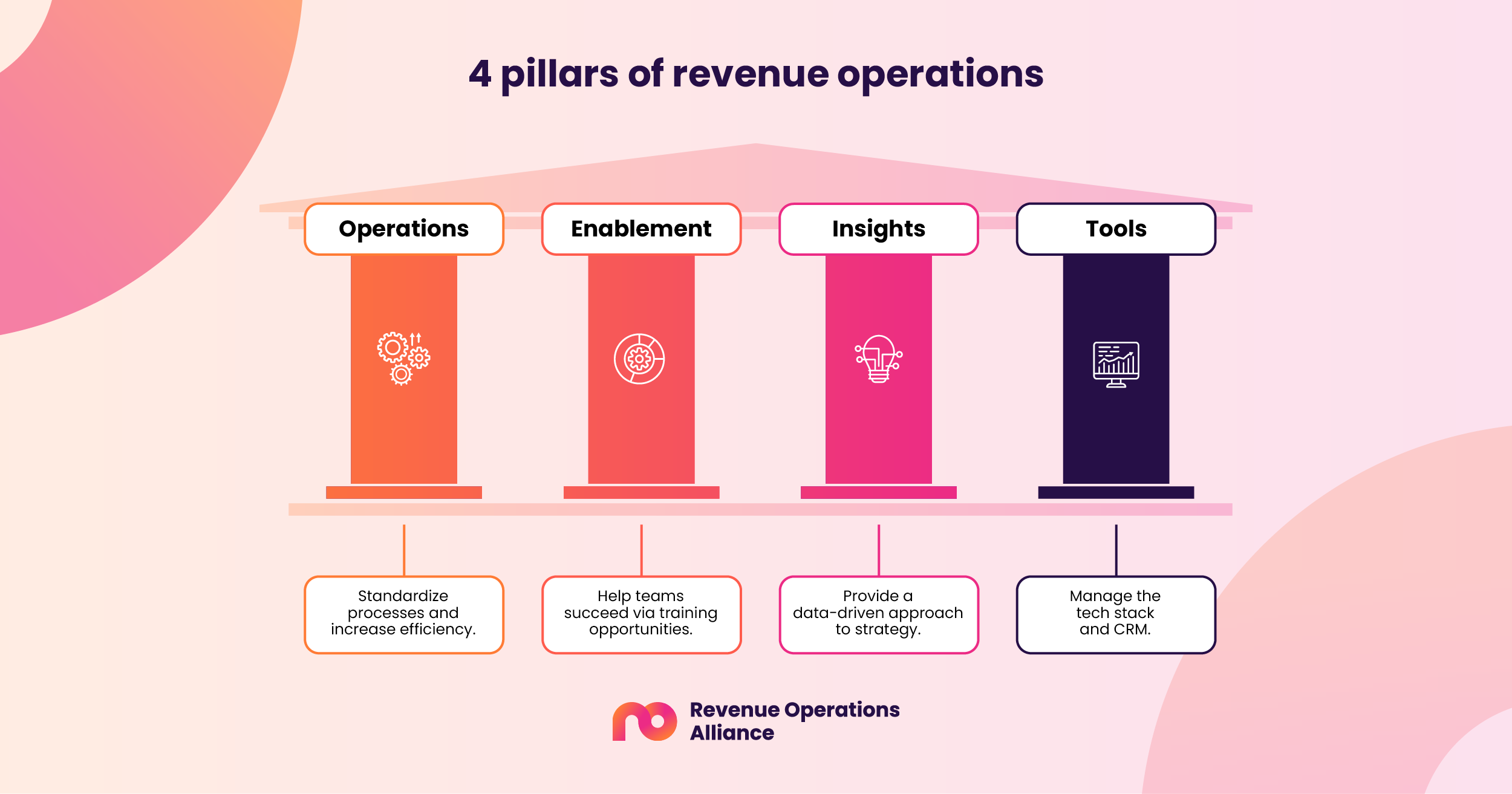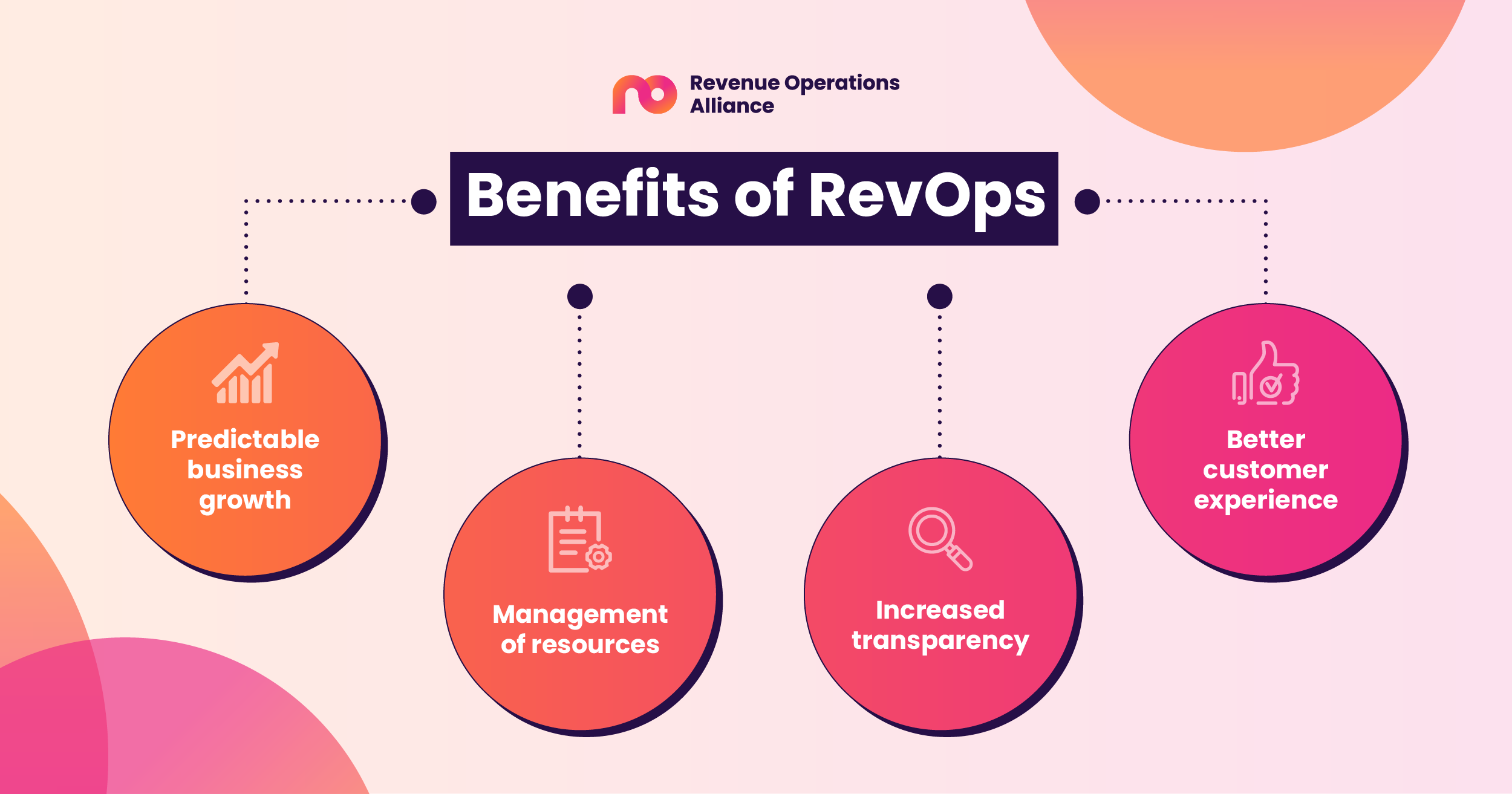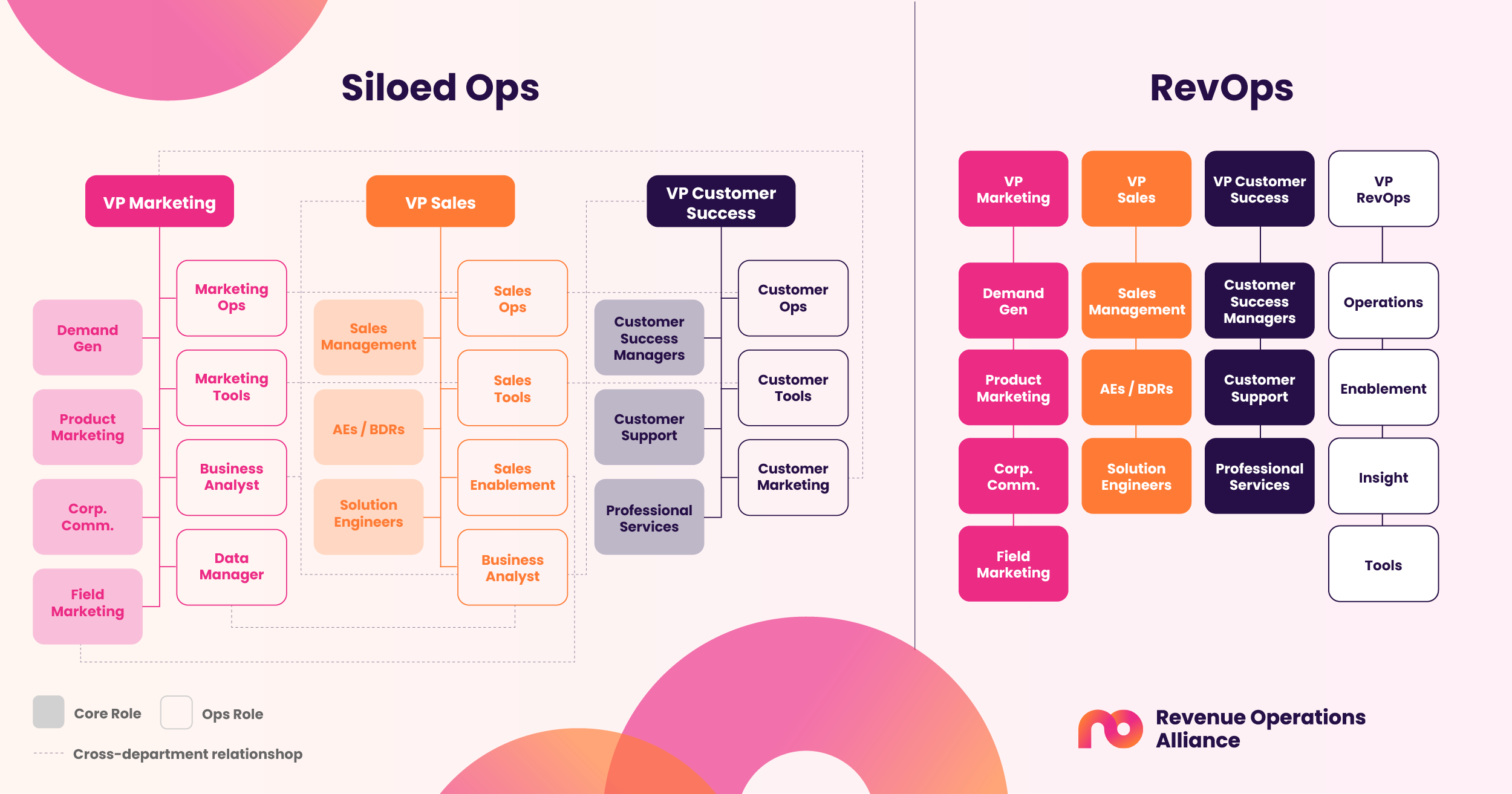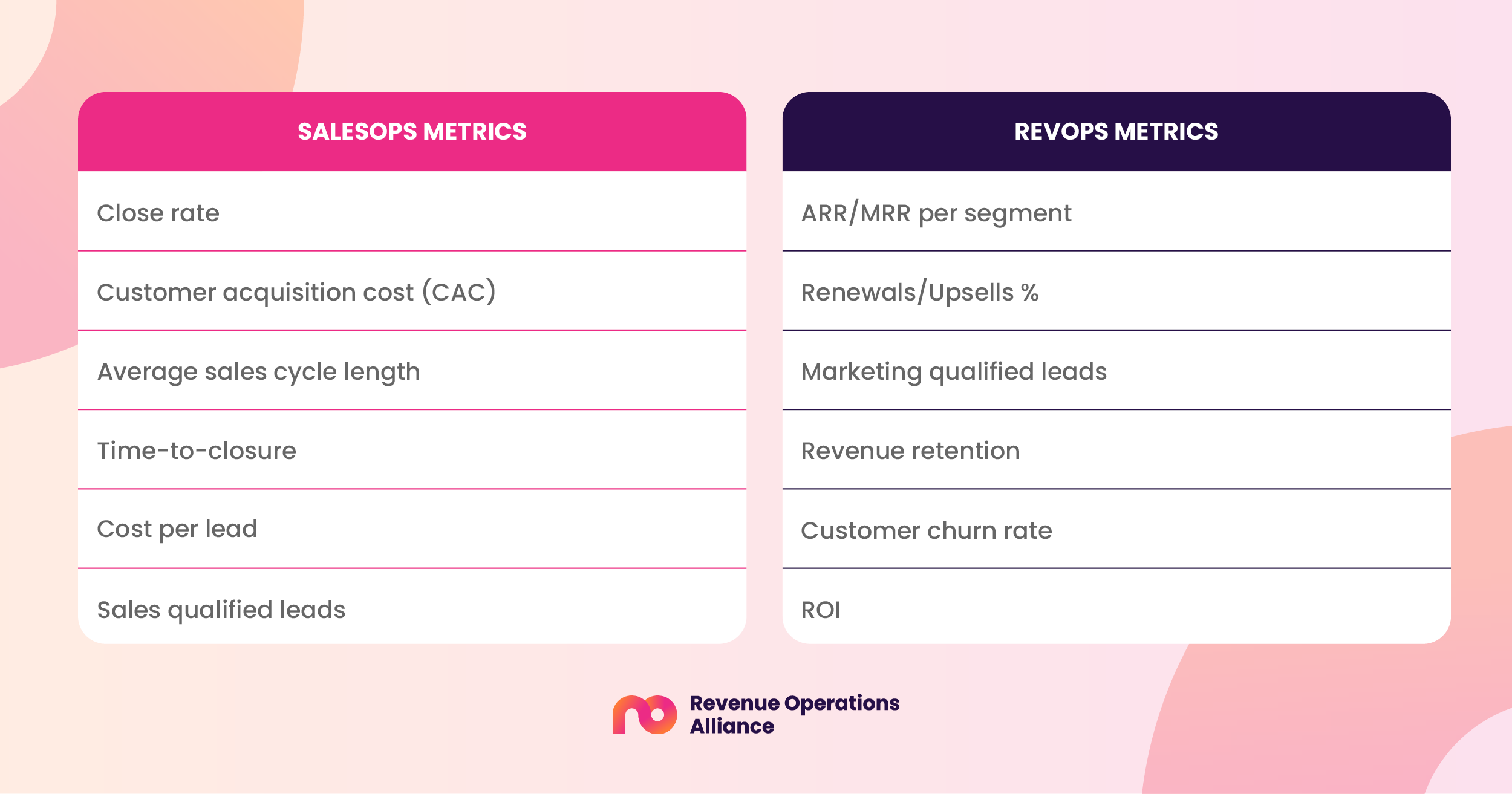Revenue operations (RevOps) is a strategic business function that aims to boost an organization's revenue growth, by aligning cross-functional teams and optimizing processes. The key aspects of RevOps include operations, enablement, insights, and tools.
“Revenue operations is the amalgamation of marketing, sales, finance, and revenue, into a symbiotic vision for the company”
- Jordan Shaheen, Director of Revenue Operations at Candid
Intrigued? Want to learn more?
This article provides a deep dive into all things revenue operations and highlights the benefits of implementing revenue operations in your business model!
We’ll take a look at:
- Defining revenue operations
- The need for RevOps
- Four pillars of RevOps
- Benefits of RevOps
- Revenue operations team structure
- RevOps vs sales ops
Defining revenue operations
Revenue operations aims to align sales, marketing, and customer success teams into one centralized unit, focusing on cohesive goals that allow companies to become revenue-growing powerhouses.
By breaking down individual arms of a business, RevOps opens communication and allows increased access to targets, data, and technology, enabling teams to perform collaboratively and work towards shared goals.
The ultimate goal of a RevOps team is to drive revenue growth across all revenue-generating functions of the business.
Prefer to listen than read? Check out this quick explainer on what RevOps is. ☝️
“RevOps looks at the total picture, not just from a strategy and KPI perspective, but also from the traditional people, process, technology, and data perspective. And this really helps us to ensure that everyone stays aligned…”
- Rosalyn Santa Elena, Vice President, Global Revenue Operations at Neo4j.

What is the need for revenue operations?
Historically, businesses have run their operations through a funnel, structuring teams as independent arms that solely focus on their specific goals. From lead generation to the sales funnel, to becoming a customer.
This method of business operations has proved successful. However, as markets become increasingly saturated, and competition within industries rises, it has never been more critical for companies to drive toward customer retention and revenue growth as a team.
Different departments within a company can often get absorbed in their own short-term goals, making coordination challenging. Though departments attempt to work toward a common goal, they can unknowingly slow progress by moving in different directions.
To compensate, revenue operations steps in to promote a unified, long-term approach to revenue generation across sales, marketing, and customer success functions.
However, the need for RevOps is more than its benefit to the internal business. According to Salesforce, 76% of customers expect consistency when interacting with varying departments of the company; however, 54% of customers feel that when communicating between different departments, it often feels like they’re interacting with entirely separate companies.
Ultimately, this leads to poor customer retention and can hamper the overall company image. Therefore, it’s no wonder that Gartner predicts that by 2025, 75% of the highest-growth companies in the world will deploy a RevOps model.
4 pillars of revenue operations
Still not sure what RevOps involves? Don’t panic - there are four things you need to know about revenue operations: operations, enablement, insights, and tools.
Let’s talk about each of them.

Operations
Operations is the name of the game. RevOps teams look to standardize processes across sales, marketing, and customer success teams to help align those teams and increase efficiency across the revenue function.
Enablement
The second element of RevOps, enablement, is all about helping teams to succeed by providing the right resources and training opportunities.
This includes maintaining rich databases of information to assist each revenue team with their roles and creating L&D programs and incentives to promote continuous learning.
RevOps teams may even work with sales enablement to plan sales team training and enable sales reps to close deals more efficiently.
Check out this podcast episode with Christian Palmer, Global Revenue Enablement Manager at Riskified, discussing the importance of RevOps and enablement functions working together to train and empower sales teams. 👇
Insights
Speaking of databases, revenue operations teams help to provide a data-driven approach to strategy and revenue growth through insights.
This data can be utilized across departments to understand lead generation, customer churn, and much more. Plus, these insights into your revenue function allow for more informed decision-making.

Tools
Finally, RevOps manages tech stacks and tools to ensure they all play nicely together. Organizations can have 10+ tools in their arsenal, and that can get messy quick.
It’s the revenue operations function that irons out inefficiencies and ensures a single source of truth for revenue data. RevOps teams can also implement automation tools into their workflow to further increase efficiency.

Benefits of revenue operations
We’ve learned what it is, but what are some of the benefits of implementing RevOps?
Predictable business growth
Without RevOps, we can’t monitor the customer lifecycle as closely as we can post-alignment. When departments share data, tools, tech, and open communication, businesses can focus on targeting each stage of the customer journey with a unified approach.
By using reliable data taken across departments, you can identify the pitfalls and strengths of your business. Using this data makes it much easier to make changes, achieve your business goals, and grow revenue.
The RevOps Difference Report concluded that 88% of companies with aligned teams met or exceeded their revenue goals, and 16% far exceeded these goals.
Management of resources
When departments work as independent puzzle pieces, opportunities to cut down on business expenditures go unnoticed. It's costly to have each department use the same tools, all on different accounts. When multiple departments are using different tools to do the same thing, it gets expensive and hard to keep track of.
After RevOps is implemented, departments begin sharing tools and tech - streamlining the purchase, implementation, and management of different tech and its usage and cutting costs throughout the business.

Increased transparency
Nobody enjoys a lousy working environment - friction between departments is draining for management and the workers within teams. Aligning your teams by implementing open communication, visibility, shared tools, and tech allows departments to better appreciate what each other does.
The Pedowitz Group found that 34% of aligned teams stated that the most significant benefit to alignment was the improvement of employee experience.
Alignment = greater accountability + improved company culture
Better customer experience
Alignment equals a better understanding of what customers like and don't. All departments communicate with the customer in the same way, creating a more accurate strategy for communication.
Customers don't enjoy mixed messages, so when your company aligns, you’re more cohesive.
What does this mean for your business?
- Accurate marketing messaging that your customers will actually interact with.
- Cohesive brand messages across departments.
- No more mixed messages - a more unified voice across departments.
- Happier, better-understood customers who enjoy interaction with you.
- Strategy based on data, meaning less revenue wasted with unsuccessful marketing, sales, or CX campaigns.

RevOps team structure
How many people are in a RevOps team?
44.4% of RevOps professionals say they work in a team of two to four. While 22% of revenue leaders work as a solo RevOps function.
Just under one-fifth (19.5%) of our RevOps teams are a team of five to nine, leaving only 17.1% of revenue operations professionals working in a team of 10+.
These statistics are from our State of Revenue Operations report.
Roles and responsibilities of the RevOps team
According to Doyle Slayton, VP of Sales and Growth at Worca, the five key roles and responsibilities of a RevOps team are:
- Building alliances
- Streamlining processes
- Data governance
- Performance analytics
- Aligned tech stack
You can read more about these five competencies here:

Who does revenue operations report to?
30.4% of revenue operations professionals report to their Chief Revenue Officer (CRO), who works cross-functionally with sales, marketing, customer success, and RevOps to optimize revenue growth.
But what if your organization doesn’t have a CRO? In that case, RevOps may report to VP Sales or CMO, however, this isn’t ideal as reporting within sales or marketing can lead to bias within the RevOps team.
Ideally, if your company doesn’t have a CRO yet your revenue operations team should report directly to the CEO. This allows RevOps to stay impartial to other departments’ problems, making them easier to prioritize and solve.
This is the case for 25.6% of RevOps leaders according to our recent State of Revenue Operations report.
Where does RevOps sit in the org structure?
As previously mentioned, RevOps should sit separately from sales, marketing, and customer success, as a unique function that collaborates with each of the revenue-generating functions.
Here is an example of how this looks compared to a more traditional, siloed approach:

By allowing RevOps to sit alone, your team can benefit from an external perspective when optimizing processes and managing change. This also allows revenue operations professionals to focus on their own long-term targets instead of being pulled into short-term revenue-boosting activities.
That’s not to say there isn’t a time and place for those short-term pushes - it’s just that RevOps strategies to streamline workflows, manage data hygiene, and implement automation tools focus more on the long-term impact on revenue streams.

Revenue operations vs sales operations
While RevOps and sales ops may sound nearly identical, there are some key differences between the two ops functions. Here is a summary:
- Department served: Sales ops only work with the sales team, while RevOps works with sales, marketing, and customer success teams.
- Impact on customers: Sales ops can increase the relationship between your sales reps and your customers during the sales cycle. However, revenue operations focus on improving CX over the entire customer journey.
- Approach to revenue streams: Sales ops only focus on closing deals, not generating new leads, while RevOps works with existing revenue streams and also helps teams to find new ones.
- Defining success: Sales ops tends to focus on sales-oriented metrics such as close rate. Whereas RevOps tends to focus more on revenue growth, tracking metrics like revenue retention.
Sales ops and RevOps also use different metrics to measure success - we summarized this in this table. 👇

Here's some bonus insights from revenue operations expert Leore Spira, Director of Revenue Operations at Blink Ops, on how RevOps differentiates from sales operations.
“I think revenue operations leaders become experts and see the full picture from the macro-level, instead of the micro because sales operations are just one step in the process, one milestone.
“Sales is now just one piece of the puzzle, and revenue operations is the full puzzle.”
Final thoughts
With some of the biggest and best companies in the world adopting RevOps, it is no wonder it has taken the operations world by storm.
Hopefully, this article has firmed up your understanding of this emerging function.
Want a place to discuss all things revenue operations? Get all your questions answered by RevOps experts. Share, collaborate, and network - Join our community today! 👇






